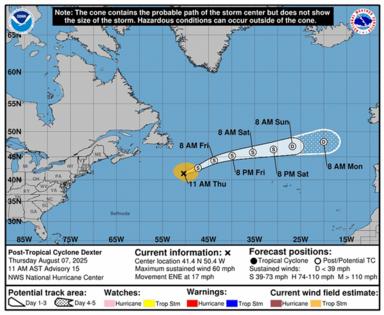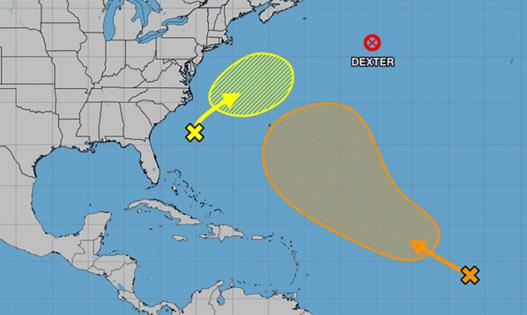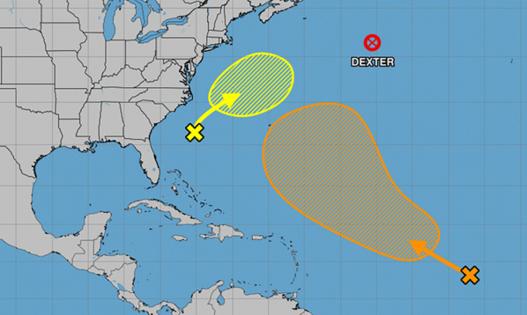Hurricane center tracks 2 Atlantic systems while Tropical Storm Dexter becomes extratropical
Published in Weather News
The National Hurricane Center on Thursday said Tropical Storm Dexter had become extratropical, but continued to keep track of two developing Atlantic systems that could become the season’s next tropical depression or storm.
As of the NHC’s 2 p.m. Eastern time tropical advisory, closer to the the U.S. but moving away is what is now expected to be a weak, nontropical area of low pressure forming a few hundred miles offshore of North Carolina.
“Some tropical or subtropical development is possible this weekend while the system moves northeastward over the warm waters of the Gulf Stream, off the east coast of the United States,” forecasters said. “By early next week, the low is expected to reach colder water and more hostile conditions, ending its chance for tropical or subtropical development.”
The NHC gave the system a 10% chance to develop in the next two days and 20% chance to develop in the next seven days.
Farther east, though, a tropical wave that has entered the central Atlantic had disorganized shower activity.
“Environmental conditions are forecast to become more conducive for gradual development in a few days, and a tropical depression could form late this weekend or early next week while the system moves west-northwestward to northwestward across the central tropical and subtropical Atlantic,” forecasters said.
The NHC gave it a 10% chance to develop in the next two days and 60% in the next seven.
The next names on the 2025 Atlantic hurricane season list are Erin and Fernand.
The season’s fourth named storm had lost its tropical characteristics after pushing through the North Atlantic this week. What had been Tropical Storm Dexter since Sunday, but transformed into Post-Tropical Cyclone Dexter remained no threat to land.
As of 11 a.m. Thursday, the center of Dexter was located about 390 miles south-southeast of Cape Race, Newfoundland moving east-northeast at 17 mph with maximum sustained winds that had grown to 60 mph. Tropical-storm-force winds extend out 185 miles.
“This general motion is expected to continue during the next few days,” forecasters said. “Dexter is expected to continue strengthening as an extratropical low through early Friday. The cyclone is forecast to weaken beginning late Friday and Saturday.”
The NHC said it had given its last advisory on the system.
Dexter became the fourth named storm following tropical storms Andrea, Barry and Chantal.
Before the start of hurricane season, the National Oceanic and Atmospheric Administration had forecast an expected 13 to 19 named storms for the year, of which 6 to 10 would grow into hurricanes. Three to five of those would develop into major hurricanes of Category 3 strength or higher.
The height of hurricane season runs from mid-August into October.
The entire six-month season runs June 1 to Nov. 30.
©2025 Orlando Sentinel. Visit at orlandosentinel.com. Distributed by Tribune Content Agency, LLC.














Comments